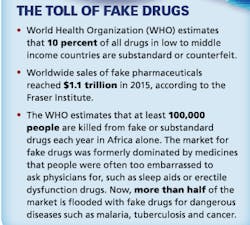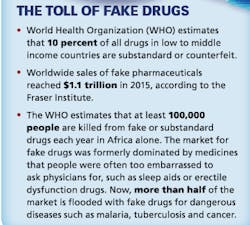The next revolution in digital technology likely belongs to blockchain. It’s already been a game-changing disrupter in the financial industry, where blockchain has allowed for the creation and rise of cryptocurrencies — a digital form of payment that allows users to exchange funds without a central bank.
Now it’s knocking on the door of the pharmaceutical world and offering a way to tackle expensive track and trace regulations and fight one of the industry’s most pressing issues: counterfeit drugs.
The World Health Organization estimates that fake drugs contribute to the deaths of at least one million people worldwide. The scourge of counterfeit drugs is not only deadly, it erodes people’s trust in pharmaceuticals, and, according to the World Customs Organization, costs the industry an estimated $75-$200 billion every year.
To help tighten and secure the pharma supply chain, the U.S. Food and Drug Administration unveiled the Drug Supply Chain Security Act (DSCSA) in 2013, which requires companies to create a system that electronically documents the journey of products from the manufacturing floor to the pharmacy. As the law stands, the deadline to fully implement the new rules is 2023.
The pressure is on companies to adopt some sort of digital solution to track its products — and more eyes are turning to blockchain as a potential answer.
Ready for Takeoff
For years, blockchain was synonymous with bitcoin, the most commonly traded cryptocurrency in the world. Although they are not one and the same, blockchain is the backbone that allows cryptocurrencies like bitcoin to be securely transferred.
Basically, the technology tracks the trading activity of a product in linked “blocks” that are recorded in a chronological “chain.” Each party involved in the movement of the product is able to track and view its status, but they can’t change any of the history. Once an activity has been recorded, no party can go back and amend it. This transparency promotes trust among the parties involved in the movement of that product.
Because of its ability to track transactions, blockchain is also a natural fit for shoring up supply chain security in the pharma world, which is becoming increasingly complex. In a manufacturing setting, the idea is to use blockchain by assigning goods a unique ID once they are packaged in the plant, then documenting the product as it changes hands with the transportation company, then documenting it again as it is loaded onto a pallet at a shipping dock, etc. until it arrives at its final destination.
Implementing this technology among so many stakeholders will require widespread adoption across the supply chain. And this complexity is partly why blockchain technology is yet to be fully developed. Yet, blockchain has successfully worked as the backbone for bitcoin for nine years, and industry experts estimate that in just a few years, blockchain will be the go-to supply chain solution.
Mark Toohey, CEO of TBSx3, a startup focused on implementing blockchain-based solutions in several industries, compared the progress of the technology to the development of aviation.
“Bitcoin proved that humans were capable of flight,” he says. “Now we’re in the biplane era and we’re going to keep building it until we’re in the jet age. There are many layers and tools to build, but it will happen.”
Toohey says he became interested in the promise of the technology after surviving cancer with the help of chemotherapy and finding out that there have been instances, even in U.S. hospitals, when patients have received fake chemo.
“[That] was a turning point,” he explains. “I said, ‘Now I know that’s what I want to do with the rest of my working career.’”
TBSx3 is ready to roll out its blockchain solution, and the company has already scored major partnerships with several key participants such as some of the biggest names in the freight shipping business, including DB Schenker and DP World Australia. TBSx3 is also in the process of working with several major pharmaceutical companies to set up trials. Toohey says he envisions that in the pharma industry, drugmakers will be the “brand owners” or investors into the solution, but then it will be available as a free application for mobile and other devices and easily implemented throughout the supply chain.
The Regulatory Fix
While TBSx3 is working on a major rollout, a California-based startup called Chronicled plans to begin trialing a new solution this summer that it calls a “baby-step” toward fully integrated blockchain.
Called MediLedger, Susanna Somerville, head of Pharma Solutions at Chronicled, describes the solution as a sort of digital phonebook that will allow users to check the authenticity of serial numbers on drugs as they move through the supply chain. It will also allow wholesalers to quickly communicate with the manufacturer on all returned product intended for resale, and allow them to comply with the law while delivering sub-second verification.
Chronicled hopes MediLedger could evolve into a network-wide solution that will be adopted by major service providers like SAP and integrated into their current track and trace platforms. Although there are multiple solutions utilizing blockchain in development — and some companies are even inventing their own solutions to stay compliant with DSCSA — Somerville says she predicts that the market will eventually migrate to well-established and tested networks.
As for the next step and implementing blockchain through the supply chain? Somerville says that will largely depend on pharma companies themselves. If more drugmakers jump into the race to create blockchain solutions, the technology will advance more quickly. But if many aim to put off DSCSA compliance until the last minute (or bank on the rules being delayed to an even later date), blockchain will sputter. The quicker this solution is developed, the faster companies will realize the further benefits of blockchain.
More in Store
For the pharmaceutical industry, the potential benefits of blockchain go beyond track and trace.
“Imagine that we have a system that is focused on recoding the shipment of drugs,” Somerville says, explaining a next-use example for blockchain. “Now take that and then automate the payments.”
At many pharma companies, there are entire departments dedicated to investigating payments in the supply chain. Once developed, blockchain technology could create an automated payment and verified receipt every time the product changes ownership.
“That is the real pot of gold waiting for these companies,” Somerville says. “They are doing it for compliance but there are huge financial savings as well.”
Chronicled is also looking at ways blockchain could be used for raw material verification, temperature monitoring with deliveries and managing chain-of-custody for centralized medicines.
Others have envisioned a way to use blockchain to streamline the clinical trials process to more quickly move compounds through the pipeline. Toohey says a recall function could also be added to their solution to help locate and round up medications.
Roadblocks to Blockchain
Although the technology has the hype and momentum to realize its full potential, there are several key hurdles to widespread adoption. Firstly, the development hasn’t been lightning fast.
“It’s a slow technology, but it is meticulous and rock-solid accurate,” Toohey says.
It’s also possible that if pharma companies have already invested in a solution for DSCSA compliance, they won’t want to make a costly leap onto the blockchain bandwagon. Uncertainty with the new technology could also prompt companies to wait and see until there’s widespread adoption and a clearer return on investment.
But as with any new technology, putting short-term cost considerations ahead of long-term investment opportunities could mean that your company misses out on the best solution. In the same way smart phones quickly progressed from a novel curiosity to transforming our daily lives, the pace of further developments with blockchain is likely to increase once it hits the big stage in the pharma world.
“It does take time for a new technology to get that deep traction, but once it does, there are winners and losers,” Toohey says. “Those who delay are often left out. The same will happen in manufacturing and finance as this new technology embeds itself.”






